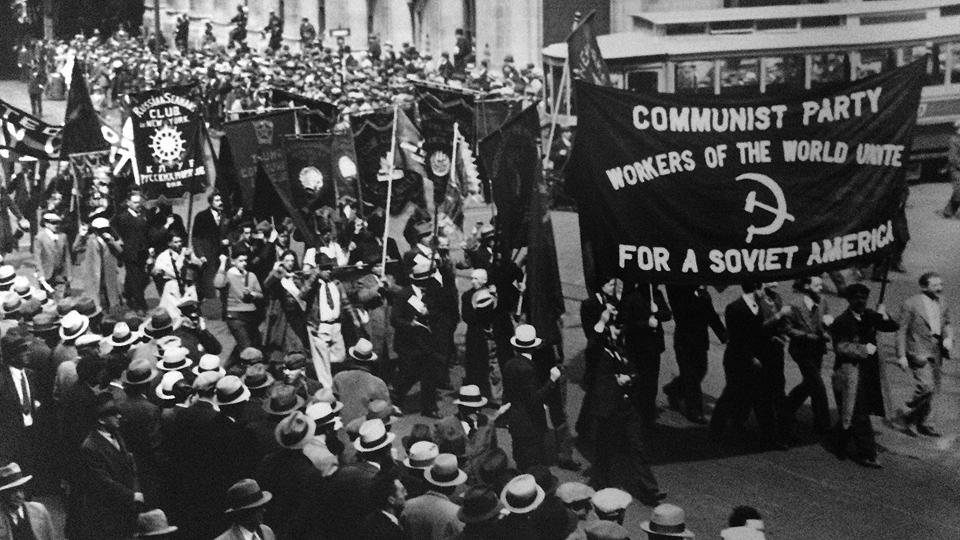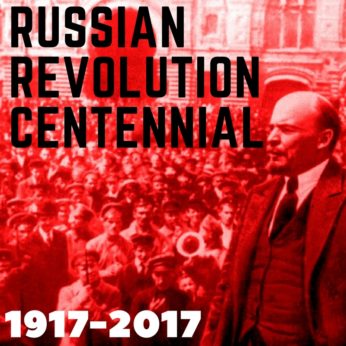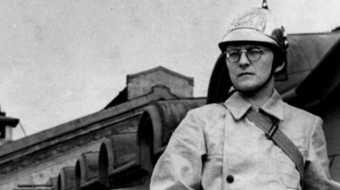
The Centennial of the Russian Revolution
November 7, 2017 marks the 100th anniversary of the Russian Revolution and the establishment of the world’s first socialist state. To commemorate the occasion, People’s World is presenting a series of articles that present wide-angled assessments of the revolution’s legacy, the Soviet Union and world communist movement which were born out of it, and the revolution’s relevance to radical politics today. Other articles in the series can be read here.
“The Soviet Union, the crystallization of the Communist program in life, and the shock-brigade of the world proletariat, rising and flourishing with its great revolutionary strength in the midst of a decaying, declining capitalist system, is the hope and guarantee of a new life for the starved and exploited of the earth.”
 William Z. Foster wrote those words when he was running for president of the United States on the Communist Party ticket in 1932. They appeared in the book, Toward Soviet America—a title which encapsulated not just the CPUSA’s election platform but its vision of the future socialist society to which it expected to lead American workers.
William Z. Foster wrote those words when he was running for president of the United States on the Communist Party ticket in 1932. They appeared in the book, Toward Soviet America—a title which encapsulated not just the CPUSA’s election platform but its vision of the future socialist society to which it expected to lead American workers.
Given that the U.S. economy was then stalled in the darkest depths of the Great Depression with no clear plan on the part of bourgeois politicians for getting out, the tendency of Foster and other radicals to look to the East for inspiration was understandable. Herbert Hoover was sitting on his hands, and FDR’s New Deal was still months away. Reports from Moscow, however, suggested utopia was under construction there. Five-Year Plans, full employment, the end of racism and national prejudices, social security for all.
But for someone born in the 1980s, it is somewhat difficult to relate to having one’s political identity be so wrapped-up in the outcome of a socioeconomic experiment unfolding on the other side of the globe. Watching the fall of the Berlin Wall on television with my mom when I was six years old is my earliest memory of encountering anything having to do with socialism or communism.
People of my generation came of age politically in the Clinton and Bush years. Capitalism was by then already the default world system. Globalization, low-wage service jobs, intermittent wars in the Balkans and Iraq, 9/11—these were the hallmarks of the world we grew up in. As for the USSR, it was so far in the historical rear-view mirror that it didn’t play much, if any, role in our political education. It just didn’t seem all that relevant by the turn of the millennium.
The notion that the inevitable future of humanity would be revealed in actual, tangible reality during our lifetimes isn’t one we can relate to. For us, the closest thing to “actually existing socialism” that we might have had the chance to see is Cuba. Its devotion to humane ideals and international solidarity is inspiring as far as it goes, but thinking the path of the United States’ development might be found in the example of an underdeveloped Caribbean island doesn’t really compute.
But just as we, the children of the 1980s and ’90s, grew up in a different world than did the generations before us, so too are the youth of today becoming radicalized under completely different circumstances. The Great Recession that started in 2008 has exposed the capitalist triumphalism of the post-Soviet period as grossly premature, and the latest crop of young left-wingers is coming on the scene at a time when the idea of socialism is enjoying a renaissance, stripped this time of any association with a particular country or party.
And so in 2017, the centennial year of the revolution with which Foster and the Communists of the twentieth century were so enamored, what relevance does the Bolshevik revolt and its legacy possess?
The image and the reality of revolution
While the vast majority of younger radicals are today engaged in movements like the Women’s March, Black Lives Matter, the Fight for $15, or various resistance efforts against Trump, there are some—often those attached to some self-proclaimed vanguard or another—who fantasize about armed rebellion, the seizure of power, and the storming of the gates. These are the idols of this “cosplay left,” who, like fans at a comic book convention, revel in re-enacting the imagined exploits of their favorite superheroes. They are the ones who can be counted on to show up at demonstrations, wave the red flag, shout some ultra-radical-sounding phrases, and perhaps, on occasion, smash a window or two. But when it comes to serious organizing and practical working-class politics, somehow these “revolutionaries” often become scarce, and quick.
They, like the stilted image of the Bolshevik Revolution which they glorify, occupy a world quite far away from the actual work of creating meaningful social change. Yet, the real Russian Revolution—and the space it created for experimentation and pragmatic socialism in the early 1920s—deserve serious study by the aspiring socialists of today. For the Soviet legacy is not just one of romantic rebellion, nor of cement walls built across the center of Europe. The real Russian Revolution had, at its heart, a liberating potential and a Marxism rooted in real-world practice that still holds lessons a century later.
That the Bolsheviks’ armed taking of state power had become historically necessary by the fall of 1917 should be relatively apparent today, even from the most moderate of progressive viewpoints. Given the pressures of war and impending famine, as well as the political bankruptcy of the Provisional Government of Alexander Kerensky, there were only a few real possible futures facing Russia in October: capitulation to Germany; a reactionary dictatorship under the likes of some monarchist general; or Bolshevik rule at the head of the workers’, soldiers’, and peasants’ Soviets (councils).
But what about the events that followed? Were Stalin’s Siberian gulags or Brezhnev’s tanks in Prague pre-ordained from the start? Certainly, there were terrible crimes and excesses on the part of the Bolsheviks during those early years of civil war. The tactics employed against counter-revolutionaries during the “Red Terror” were so extreme that those charged with carrying them out were sometimes wrecked mentally. It is reported, for instance, that Felix Dzerzhinksy, the head of the secret police at the time, had to drown his stresses in the bottle to make it through his tasks.
Of course, the revolution’s problems were not just internal. Imperialist strangulation—economic blockade as well as invasion by foreign armed forces, including those of the U.S.—drove Russia to the brink. “War Communism,” which as the name implied, was an emergency survival strategy. It became official policy in 1918. It meant forced grain requisitions from peasants, military-style discipline in the workplace, wage-leveling, total state takeover of private industry, and the dedication of all available resources to the military effort. Not exactly the bright socialist future of workers’ democracy and economic abundance that had inspired the storming of the Winter Palace.
Red Terror and authoritarianism. Those are the only aspects of the revolution that its opponents—both then and now—ever want to focus on. But for the socialists of today, the more interesting period of the early Russian Revolution is 1921-28—the time of the New Economic Policy (NEP).
Pragmatic socialism
It was long widely believed, by both friends and enemies of socialism, that there was only one successful model of socialist development: The Soviet-style centrally-planned economy. Such a belief is a product of the 1930s and the post-war period, however, not of the early Russian Revolution.
After the euphoria of the initial overthrow of czarism faded and the desperate struggle against counter-revolution seemed to at least temporarily have passed, Lenin and his Bolshevik comrades faced the task of actually orchestrating the transition to a socialist society. I say orchestrating because the country wasn’t ready, materially. The Bolsheviks were frankly at a loss about what to do after the failure of left-wing uprisings in other countries.
The world’s first socialist revolution had occurred in Russia of all places—an autocratic, partially industrialized country only a few decades removed from serfdom. This was not the type of highly developed bourgeois-democratic capitalist society which Marx and Engels had envisioned would be first to embark on the road to socialism.
Lenin, even in the first years after October 1917, still believed the traditional Marxist faith. He understood the underdeveloped position of Soviet Russia and was aware of the difficulty of constructing socialism. Initially, he thought that socialist revolution would break out in one or more of the industrialized capitalist countries and that they would then assist Russia. “Soon,” he wrote, “after the victory of the proletarian revolution in at least one of the advanced countries, a sharp change will come about.” Then, he claimed, “Russia will cease to be the model and will once again become a backward country.”
By 1921, it was pretty clear that there was not going to be any revolution in the advanced capitalist world any time soon. The response of Lenin and the Russian Communists to that stark reality was to dispense with pre-conceived schematics. In some ways, it was back to the Marxist basics. The old historical materialist adage that no social order perishes “before all the productive forces for which there is room in it have developed” took on a fresh relevance. What Russia needed was to industrialize and grow its economy. A premature proclamation of socialism wasn’t going to do the trick.
Enter the NEP: limited de-nationalization of public companies, private markets for agricultural goods, concessions to foreign private investment, production decisions based on supply and demand, and economic administrators trained in capitalist management methods.
Was it a retreat? Absolutely. Lenin didn’t hesitate to admit as much. The state still formulated an overall plan for the economy, but it was achieved primarily through market means, not government decrees. Economic competition defined relations between the public and private sectors. Paraphrasing the sentiments of purists of the day, Lenin said, “If Communists have gone to the length of saying that the immediate task is to engage in trade, in ordinary, common, vulgar, paltry trade, what can remain of communism? Is this not enough to make anyone throw up his hands in despair and say, ‘All is lost’?”
His experiment, which saw a rapid turnaround of Soviet Russia’s economic fortunes, was a short-lived one, though. By the end of the ’20s, Lenin was dead and Stalin was calling for the “squeezing out” of any traces of private industry. The consolidation of the command economy got underway, and the prototype of what today is often called a “socialist-oriented market economy” was rather quickly snuffed out. It wouldn’t be attempted again on a mass scale until 1978 when a Chinese reformer named Deng Xiaoping started ruminating on the need for his impoverished nation to “seek truth from facts,” in a blend of traditional Chinese thought and Marxist philosophy.
The unappreciated past
While the specific economic details and theoretical analysis that went into development of the NEP and the market socialist model are interesting, they are not really the most important takeaway here. The key thing to draw from the NEP story is that many of the socialists who led the October Revolution were both idealists and pragmatists. They may have been radicalized by the injustices of an old order and inspired by visions of a new one, but they matched their revolutionary enthusiasm with an understanding of the world as it was. They appreciated the observation that men may make their own history, but not under conditions of their choosing.
The pragmatic socialism of the NEP period, its melding of theory and practice with a disdain for dogma, is perhaps one of the most underappreciated legacies of October. By the time William Z. Foster and the CPUSA was praising the Soviet Union in 1932, a different kind of socialism and a more monolithic Marxism(-Leninism) was already entrenched there. Saying as much doesn’t mean the U.S. Communists of the Depression era are deserving of any particular criticism. Like all of us, they were products of their time.

But from our vantage point, 100 years out from the October Revolution rather than 15, we now have both the good fortune of hindsight and the responsibility as activists for social change to take in the full breadth of the socialist experience in the Soviet Union.
There was a Soviet past that we of the millennial (or just slightly pre-millennial) generation never knew. That was the USSR which Foster and later Communists were so drawn to—whether of the “socialism in one country” variety of the ’30s or the “developed socialism” of the ’70s.
But there is another largely unknown, or at least unappreciated, Soviet past. The time of experimentation and pragmatic socialism of the NEP period is one that all socialists, of whatever generation, should revisit.










